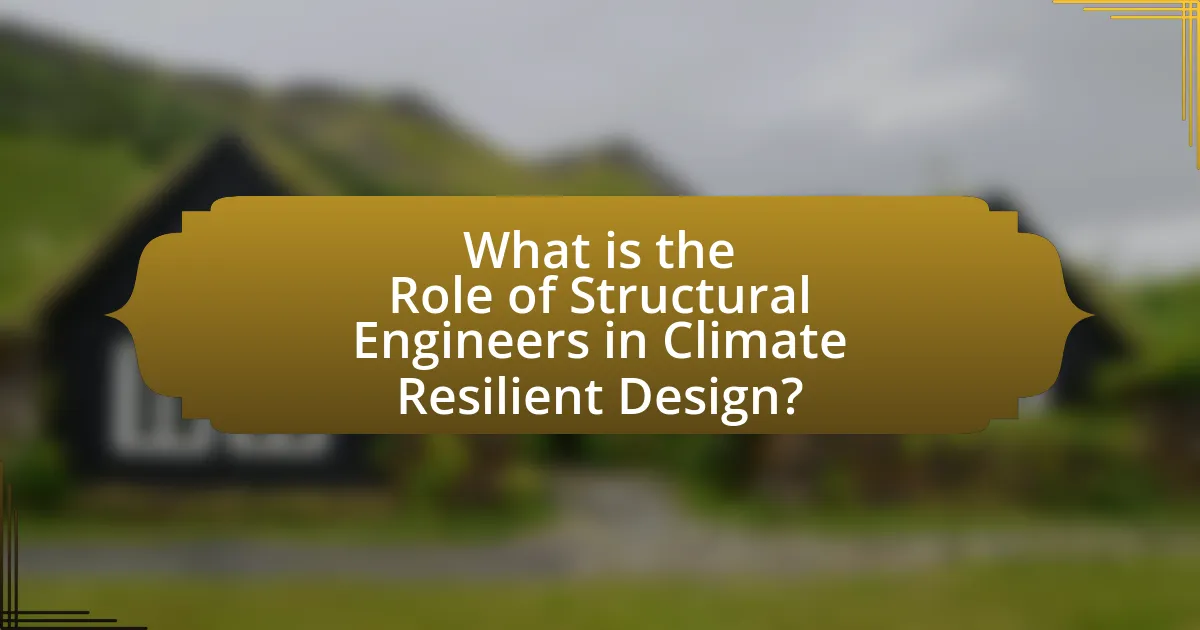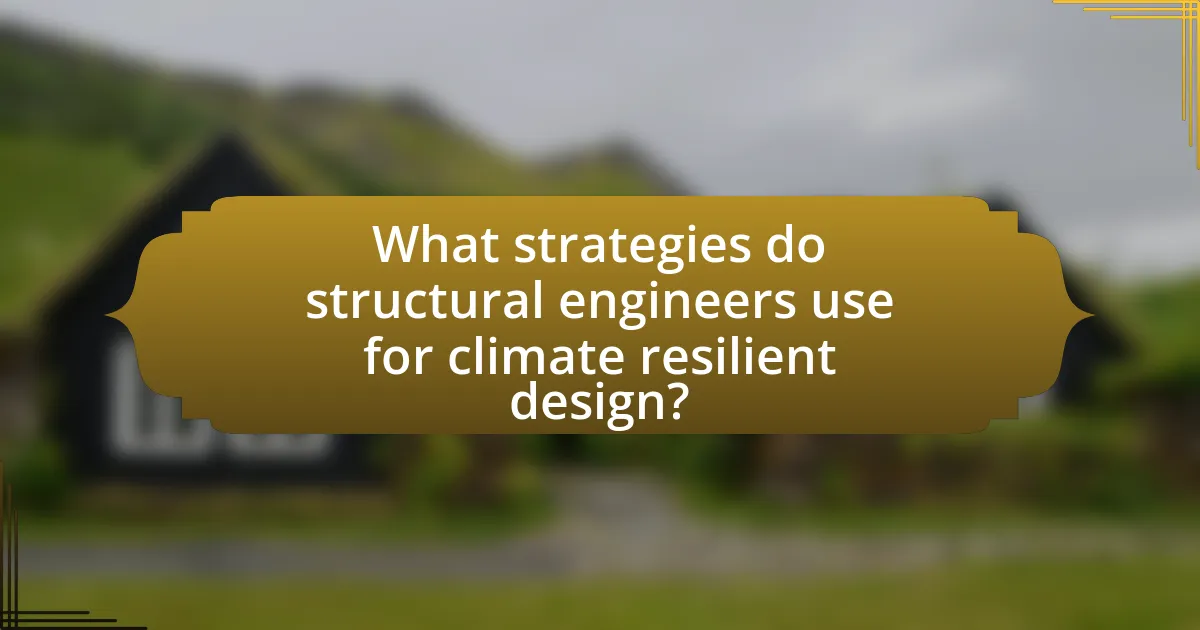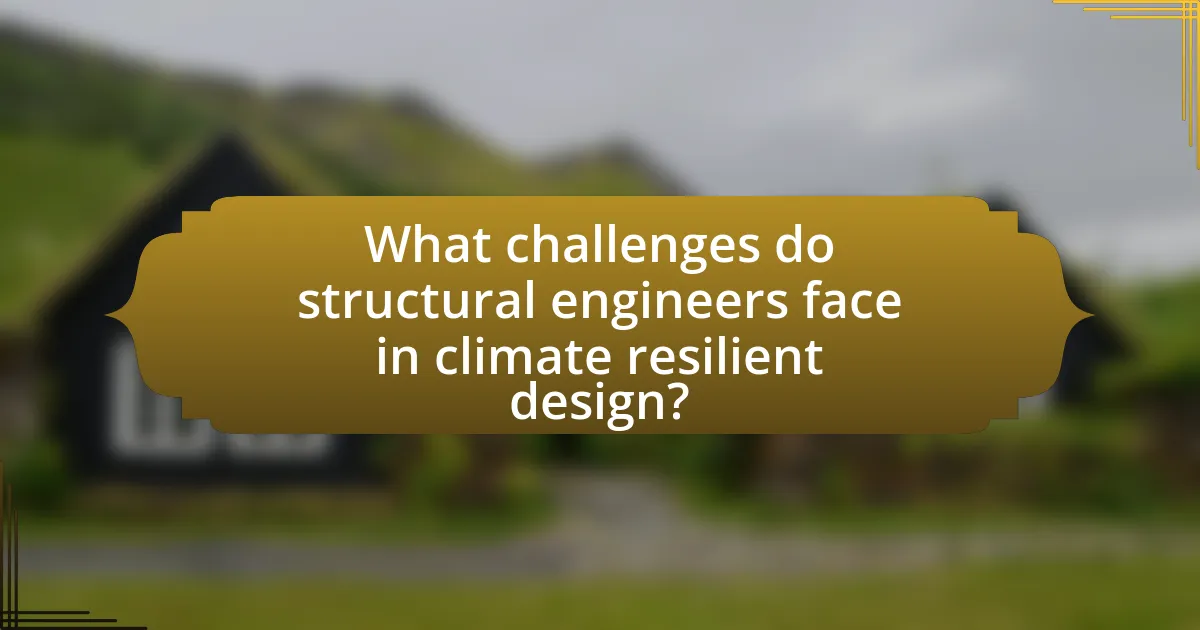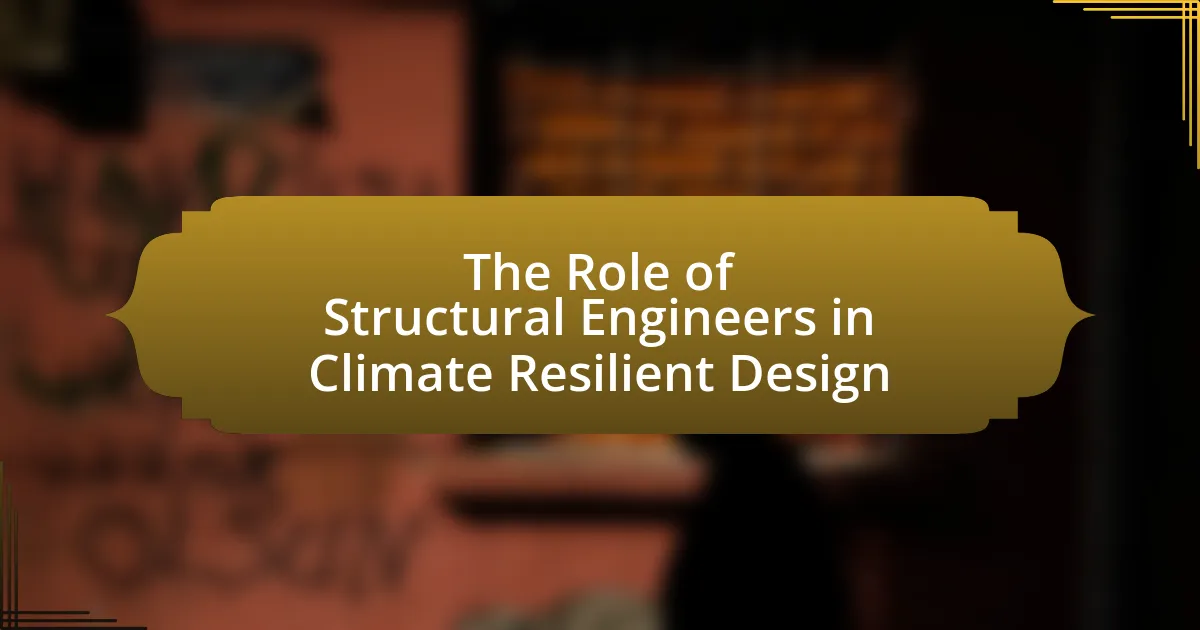Structural engineers are pivotal in climate-resilient design, tasked with ensuring that buildings and infrastructure can endure the effects of climate change, including extreme weather and rising sea levels. They utilize advanced materials and innovative design techniques to enhance durability and sustainability, incorporating features like flood-resistant foundations and energy-efficient systems. The article explores the specific skills structural engineers bring to climate resilience, their methods for assessing climate risks, and the importance of integrating sustainable materials and adaptive design principles. It also addresses the financial implications of climate-resilient design, regulatory challenges, and best practices for engineers to enhance resilience in their projects.

What is the Role of Structural Engineers in Climate Resilient Design?
Structural engineers play a critical role in climate-resilient design by ensuring that structures can withstand the impacts of climate change, such as extreme weather events and rising sea levels. They achieve this by employing advanced materials and innovative design techniques that enhance the durability and adaptability of buildings and infrastructure. For instance, structural engineers may incorporate features like elevated foundations, flood-resistant materials, and energy-efficient systems to mitigate risks associated with climate change. Their expertise is essential in creating sustainable designs that not only meet current safety standards but also anticipate future environmental challenges, thereby contributing to the overall resilience of communities.
How do structural engineers contribute to climate resilience?
Structural engineers contribute to climate resilience by designing buildings and infrastructure that can withstand extreme weather events and changing environmental conditions. They utilize advanced materials and innovative design techniques to enhance the durability and sustainability of structures, ensuring they remain functional during floods, hurricanes, and other climate-related challenges. For instance, the use of flood-resistant foundations and wind-resistant frameworks can significantly reduce damage during severe weather, as evidenced by the increased resilience of structures built to updated building codes following Hurricane Sandy in 2012. Additionally, structural engineers incorporate energy-efficient systems and sustainable materials, which not only reduce the carbon footprint of buildings but also promote long-term environmental health.
What specific skills do structural engineers bring to climate resilient design?
Structural engineers bring expertise in load analysis, material science, and design optimization to climate-resilient design. Their skills enable them to assess and enhance the structural integrity of buildings and infrastructure against climate-related stresses such as extreme weather events, flooding, and seismic activity. For instance, structural engineers utilize advanced modeling techniques to predict how structures will respond to environmental changes, ensuring that designs can withstand increased wind loads or rising sea levels. Additionally, their knowledge of sustainable materials and construction practices contributes to reducing the carbon footprint of projects, aligning with global sustainability goals.
How do structural engineers assess climate risks in their projects?
Structural engineers assess climate risks in their projects by conducting comprehensive risk assessments that evaluate potential climate impacts on structural integrity. They analyze historical climate data, project location, and future climate projections to identify risks such as flooding, extreme temperatures, and wind loads. For instance, the National Oceanic and Atmospheric Administration (NOAA) provides climate data that engineers use to model potential scenarios and design structures that can withstand these conditions. Additionally, engineers may employ tools like climate resilience frameworks and software simulations to quantify risks and inform design decisions, ensuring that structures are adaptable to changing climate conditions.
Why is climate resilient design important for structural engineering?
Climate resilient design is crucial for structural engineering because it ensures that structures can withstand the impacts of climate change, such as extreme weather events and rising sea levels. This approach minimizes damage and enhances the longevity and safety of buildings and infrastructure. For instance, the National Oceanic and Atmospheric Administration (NOAA) reports that climate-related disasters have increased significantly, with costs exceeding $1 trillion in the last decade alone. By integrating climate resilience into design practices, structural engineers can reduce vulnerability, protect investments, and promote sustainable development in the face of changing environmental conditions.
What are the potential impacts of climate change on infrastructure?
Climate change can significantly impact infrastructure by increasing the frequency and severity of extreme weather events, leading to damage and degradation. For instance, rising sea levels can inundate coastal infrastructure, while more intense storms can cause flooding and structural failures. According to the National Oceanic and Atmospheric Administration (NOAA), the U.S. has experienced a 20% increase in heavy rainfall events since 1950, which directly affects the integrity of roads, bridges, and buildings. Additionally, temperature fluctuations can lead to material fatigue and reduced lifespan of infrastructure components, as noted in the American Society of Civil Engineers’ 2021 Infrastructure Report Card. These factors necessitate the integration of climate resilience into engineering practices to mitigate risks and enhance the durability of infrastructure systems.
How does climate resilient design enhance safety and sustainability?
Climate resilient design enhances safety and sustainability by integrating adaptive strategies that mitigate the impacts of climate change on structures and communities. This approach involves using materials and designs that withstand extreme weather events, such as floods and hurricanes, thereby reducing the risk of structural failure and ensuring occupant safety. For instance, buildings designed to be flood-resistant can significantly lower the likelihood of water damage, which not only protects human life but also minimizes economic losses. Additionally, climate resilient design promotes sustainability by incorporating energy-efficient systems and renewable resources, which reduce carbon footprints and enhance resource conservation. Research indicates that implementing such designs can lead to a 30% reduction in energy consumption, further supporting environmental sustainability.

What strategies do structural engineers use for climate resilient design?
Structural engineers employ various strategies for climate-resilient design, including the use of sustainable materials, adaptive design principles, and advanced modeling techniques. Sustainable materials, such as recycled steel and low-carbon concrete, reduce the environmental impact of structures while enhancing durability. Adaptive design principles allow structures to respond to changing climate conditions, such as incorporating flexible foundations to withstand flooding or seismic activity. Advanced modeling techniques, including climate simulation and risk assessment tools, enable engineers to predict potential climate impacts and design accordingly. These strategies collectively enhance the resilience of structures against climate-related challenges, ensuring safety and longevity.
How do structural engineers incorporate sustainable materials?
Structural engineers incorporate sustainable materials by selecting resources that minimize environmental impact and enhance energy efficiency. They often utilize materials such as recycled steel, bamboo, and reclaimed wood, which reduce the carbon footprint associated with new material production. For instance, using recycled steel can save up to 74% of energy compared to producing new steel, according to the American Iron and Steel Institute. Additionally, structural engineers may implement life cycle assessments to evaluate the environmental effects of materials throughout their lifespan, ensuring that choices align with sustainability goals. This approach not only addresses immediate structural needs but also contributes to long-term ecological benefits.
What are the benefits of using sustainable materials in construction?
Using sustainable materials in construction significantly reduces environmental impact and enhances resource efficiency. Sustainable materials, such as bamboo, recycled steel, and reclaimed wood, minimize waste and lower carbon emissions during production and transportation. For instance, the use of recycled steel can reduce energy consumption by up to 75% compared to virgin steel production. Additionally, sustainable materials often improve indoor air quality and promote healthier living environments, as they typically contain fewer harmful chemicals. This aligns with the growing demand for eco-friendly building practices, which can lead to increased market value and appeal for properties constructed with sustainable materials.
How do these materials contribute to overall project resilience?
Materials contribute to overall project resilience by enhancing durability, adaptability, and sustainability in structural designs. For instance, using high-performance concrete and advanced composites can significantly improve a structure’s ability to withstand extreme weather events, such as hurricanes or floods, thereby reducing damage and repair costs. Additionally, materials like recycled steel and sustainably sourced timber not only lower the carbon footprint but also promote environmental sustainability, which is crucial for long-term resilience. Research indicates that structures designed with resilient materials can reduce lifecycle costs by up to 30%, demonstrating their effectiveness in maintaining structural integrity over time.
What design techniques are employed by structural engineers for resilience?
Structural engineers employ various design techniques for resilience, including the use of adaptive design, redundancy, and robust materials. Adaptive design allows structures to respond to changing environmental conditions, such as climate change, by incorporating features that can adjust to different loads and stresses. Redundancy involves creating multiple load paths within a structure, ensuring that if one component fails, others can take on the load, thereby preventing catastrophic failure. Additionally, the use of robust materials, such as high-performance concrete and steel, enhances a structure’s ability to withstand extreme weather events and seismic activity. These techniques are supported by research indicating that resilient design significantly reduces damage and repair costs during disasters, as evidenced by studies from the National Institute of Standards and Technology.
How do engineers utilize adaptive design principles?
Engineers utilize adaptive design principles by creating structures that can respond to changing environmental conditions and user needs. This approach involves integrating flexible materials, modular components, and responsive technologies that allow buildings to adjust to factors such as climate variability, occupancy changes, and natural disasters. For instance, the use of smart building systems can optimize energy consumption based on real-time data, enhancing sustainability and resilience. Research indicates that adaptive design can significantly reduce the risk of structural failure during extreme weather events, as seen in projects like the Bosco Verticale in Milan, which incorporates green architecture to mitigate urban heat effects.
What role does technology play in enhancing design resilience?
Technology significantly enhances design resilience by enabling advanced modeling, simulation, and analysis tools that predict structural performance under various environmental conditions. These tools allow structural engineers to assess potential risks and optimize designs for durability against climate-related challenges, such as extreme weather events. For instance, software like Building Information Modeling (BIM) integrates data to improve decision-making and resource management, leading to more resilient structures. Additionally, technologies such as sensors and IoT devices provide real-time monitoring of structural health, allowing for timely interventions and maintenance, thereby extending the lifespan and safety of buildings.

What challenges do structural engineers face in climate resilient design?
Structural engineers face several challenges in climate-resilient design, primarily including the need to adapt to increasing climate variability and extreme weather events. These challenges arise from the necessity to incorporate new materials and technologies that can withstand such conditions, while also ensuring cost-effectiveness and sustainability. For instance, the American Society of Civil Engineers (ASCE) highlights that climate change can lead to more frequent flooding, hurricanes, and heatwaves, which require engineers to rethink traditional design approaches. Additionally, structural engineers must navigate regulatory frameworks that may not yet account for future climate scenarios, complicating compliance and project approval processes.
How do regulatory frameworks impact structural engineering practices?
Regulatory frameworks significantly influence structural engineering practices by establishing safety standards, design codes, and compliance requirements that engineers must follow. These frameworks ensure that structures are designed to withstand environmental challenges, such as extreme weather events, which are increasingly relevant in the context of climate resilience. For instance, the International Building Code (IBC) provides guidelines that address seismic, wind, and flood risks, compelling engineers to incorporate these considerations into their designs. Compliance with such regulations not only enhances public safety but also promotes sustainable practices by encouraging the use of materials and methods that reduce environmental impact.
What are the common regulatory challenges faced by engineers?
Engineers commonly face regulatory challenges such as compliance with evolving building codes, environmental regulations, and safety standards. These challenges arise due to the need to adapt to new technologies and materials while ensuring public safety and environmental protection. For instance, the International Building Code frequently updates to incorporate advancements in sustainability and resilience, requiring engineers to stay informed and adjust their designs accordingly. Additionally, engineers must navigate complex permitting processes that can vary significantly by jurisdiction, which can delay project timelines and increase costs.
How can engineers navigate these regulatory hurdles effectively?
Engineers can navigate regulatory hurdles effectively by staying informed about local, state, and federal regulations relevant to climate-resilient design. This involves actively engaging with regulatory bodies, participating in workshops, and utilizing resources such as the International Code Council’s guidelines, which provide comprehensive standards for building practices. Additionally, collaboration with multidisciplinary teams, including environmental scientists and urban planners, enhances understanding of compliance requirements and fosters innovative solutions that meet regulatory standards. By leveraging technology, such as Building Information Modeling (BIM), engineers can simulate compliance scenarios, ensuring designs adhere to regulations while optimizing for climate resilience.
What are the financial implications of climate resilient design?
Climate resilient design has significant financial implications, primarily through cost savings in disaster recovery and reduced insurance premiums. By investing in resilient infrastructure, organizations can minimize the economic impact of climate-related events, which, according to the National Institute of Building Sciences, can save $6 for every $1 spent on resilience measures. Additionally, climate resilient design can enhance property values and attract investment, as properties built to withstand climate impacts are often more desirable. This approach also leads to lower maintenance costs over time, as resilient structures typically require less frequent repairs and replacements due to their durability against extreme weather conditions.
How do initial costs compare to long-term savings in resilient projects?
Initial costs for resilient projects are typically higher than conventional projects, but they lead to significant long-term savings. For instance, a study by the National Institute of Building Sciences found that every dollar invested in disaster mitigation can save society an average of six dollars in future disaster costs. This demonstrates that while upfront investments may be substantial, the reduction in repair costs, insurance premiums, and economic losses over time justifies the initial expenditure. Additionally, resilient designs often enhance energy efficiency, resulting in lower utility bills, further contributing to long-term financial benefits.
What funding opportunities exist for climate resilient initiatives?
Funding opportunities for climate resilient initiatives include government grants, private sector investments, and international funding programs. For instance, the U.S. government offers grants through the Federal Emergency Management Agency (FEMA) and the Environmental Protection Agency (EPA) specifically aimed at enhancing climate resilience. Additionally, organizations like the Green Climate Fund provide financial assistance to developing countries for climate adaptation projects. According to the Global Environment Facility, over $4 billion has been allocated to support climate resilience initiatives globally, demonstrating the significant financial resources available for such projects.
What best practices can structural engineers adopt for effective climate resilient design?
Structural engineers can adopt several best practices for effective climate-resilient design, including the use of sustainable materials, incorporation of adaptive design strategies, and implementation of robust risk assessment methodologies. Utilizing sustainable materials, such as recycled steel and low-carbon concrete, reduces the environmental impact of construction and enhances durability against climate-related stresses. Adaptive design strategies, like designing for future climate scenarios and incorporating flexible building systems, allow structures to withstand changing environmental conditions. Furthermore, robust risk assessment methodologies, which include evaluating potential climate hazards and integrating resilience measures into the design process, ensure that structures can endure extreme weather events. These practices are supported by research indicating that buildings designed with resilience in mind can significantly reduce damage and repair costs during climate-related incidents.
How can collaboration with other disciplines enhance resilience efforts?
Collaboration with other disciplines enhances resilience efforts by integrating diverse expertise and perspectives, leading to more comprehensive solutions. For instance, structural engineers working alongside environmental scientists can better assess the impacts of climate change on infrastructure, allowing for designs that withstand extreme weather events. A study by the National Academy of Sciences highlights that interdisciplinary approaches can improve risk assessment and resource allocation, ultimately resulting in more effective resilience strategies. By leveraging the strengths of various fields, such as urban planning, ecology, and engineering, communities can develop adaptive systems that are more robust against future challenges.
What ongoing education and training should engineers pursue for climate resilience?
Engineers should pursue ongoing education and training in climate science, sustainable design practices, and risk assessment methodologies to enhance climate resilience. This includes specialized courses in climate adaptation strategies, materials science focused on sustainability, and advanced modeling techniques for predicting climate impacts on infrastructure. For instance, the American Society of Civil Engineers offers resources and certifications that focus on sustainable engineering practices, which are essential for adapting to climate change. Additionally, participation in workshops and conferences related to climate resilience can provide engineers with the latest research and practical applications in the field, ensuring they remain informed about evolving challenges and solutions.

Leave a Reply